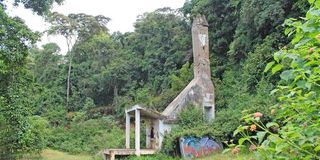Guidebook for people’s forest

The old chimney-stack in Karura Forest. PHOTO | JAN FOX| NATION MEDIA GROUP
What you need to know:
- That Karura Forest is a well-managed, safe space that we enjoy today really is miraculous.
- Given its proximity to the city, Karura became a convenient dumping ground for household garbage and industrial waste, and even corpses.
“It seems nothing short of miraculous, looking back, that Karura Forest Reserve still exists given the pressures it faced during the latter half of the 20th Century.” This is the opening to a chapter in the Karura visitors’ guide published in October 2019.
It goes on to describe these pressures in detail – destructive political and criminal activities rooted in the flawed policies of the colonial administration, and exacerbated by the corruption of the Moi government. That Karura Forest is a well-managed, safe space that we enjoy today really is miraculous.
By the mid-1980s, all of Kenya’s forest reserves were in crisis. Under the management of a poorly-funded Kenya Forest Department, many had been infiltrated by gangs of loggers, charcoal makers, firewood collectors and bush-meat hunters.
Given its proximity to the city, Karura became a convenient dumping ground for household garbage and industrial waste, and even corpses. Criminals conducted raids in adjacent suburbs, and retreated to the forest to evade the police.
Dark decades
The guidebook paints quite a picture of these ‘dark decades’, of nefarious characters and activities, and of residents armed with golf clubs and other makeshift weapons, who braved a walk in the forest.
Up to the late ‘90s, almost a third of the forest had been secretly allocated to crooked property developers, and it was when the clearing of the forest began in 1998 that opposition from the public intensified. It was at this point that environmental activist, Prof Wangari Maathai, joined the movement.
The brutal response to the peaceful demonstrations that she led attracted worldwide attention, and the government eventually backed down. Since then, overdue policy changes have improved the protection of forests across the country, and the work of the Friends of Karura Community Forest Association (FKF) has been a huge success.
FKF published the guidebook, written and edited by Gordon Boy, to mark the association’s 10-year anniversary. As well as detailing the chequered history of Karura Forest, it documents in well-illustrated chapters the forest’s diverse flora and fauna, and fascinating excavations of the two popular caves on opposite banks of the Karura River valley.
Useful information
There is also a factfile, a section with useful general information and a map of both the main forest and the Sigiria block on the western side of Limuru Road.
Having read the guide, I was keen to explore areas that I had missed on previous visits. So last Saturday afternoon, I bundled my bike into the boot of my car and headed to the forest. I was especially determined to find the distinctive chimney-stack by the eastern boundary.
This tall, bizarre structure is a fitting symbol of some of the strange activities that took place in the forest during its darker days. It once belonged to the Central Bank of Kenya, and formed part of an incinerator used for the burning – under armed escort – of decommissioned currency notes.
I had to lug my bike through a tangle of bushes to find the chimney, but it lent my excursion a sense of discovery.
I cycled back towards the River Café along the smooth Middle Track, and swung by Lily Lake. The guide had taught me a lot about this pretty spot, which I wouldn’t have known. I learnt that it used to be a grey-stone quarry that provided the bricks for the building of early suburban homesteads. And at one point it was the site of a clandestine chang’aa distillery.
We are lucky to have such a peaceful, natural space within our city in which to unwind. And I appreciate it far more now that I know how close we were to losing it.
You can pick a copy of the guidebook for Sh500 at the FKF office at Limuru Gate.
Fox is a director of iDC





